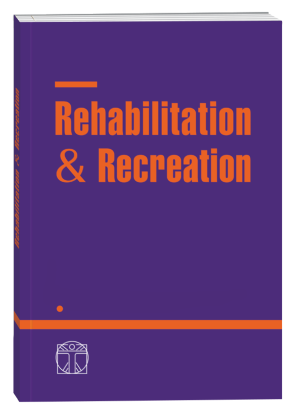COMPLEX ACTION OF PREFORMED PHYSICAL FACTORS IN SHOULDER PLEXITIS
DOI:
https://doi.org/10.32782/2522-1795.2023.14.16Keywords:
plexitis, physiotherapy, degenerative reactions, pain.Abstract
The article highlights the main problems of shoulder plexitis as a multifactorial disease. It is emphasized that plexitis of the shoulder joint often interacts with inflammatory degenerative reactions. This leads to increased morbidity and increased symptoms. Due to the fact that plexitis progresses, inaction and unwillingness to treat can lead to unpleasant consequences. The expediency of undergoing procedures to prevent inflammation of the joints is argued. At the current stage of the development of rehabilitation techniques, the author highlights the increasing popularity of reflexology, acupuncture and segmental massage. It is emphasized that the competent implementation of modern medical technologies depends on purposeful work on prevention and human recovery. Purpose: to investigate the problem of brachial plexitis, to develop a project of a scientifically based rehabilitation program for patients with damage to the trunk of the brachial plexus using preformed factors. Materials: analysis of scientific and methodical literature and information sources on the research topic; sociological; method of scientific deduction; methods of multivariate statistical analysis and forecasting – for data processing. Ten patients with a previously established clinical diagnosis (MKH-10: S14.3) at the Skalyansky Clinic LLC took part in the study. Goniometry of the shoulder joint, assessment of pain on a numerical scale at the endpoints of the range of motion and trigger points were performed before the intervention at the end of the first week of the intervention, at the end of the second and third weeks. The histories of 56 patients with injuries of the trunk of the brachial plexus were retrospectively analyzed. The quality of life of examined patients with brachial plexus trunk injuries was determined using the Dash Outcome Measure questionnaire. Results. Antibiotic therapy, antiviral therapy, immobilization of damaged shoulder joints, and correction of metabolic disorders were carried out as indicated. A common line of treatment is vasoactive and metabolic therapy, which improves nutrition and leads to rapid recovery of nerve fibers. At the current stage of development of rehabilitation techniques, reflexology, acupuncture and segmental massage are gaining more and more popularity. A comparative analysis of the results of rehabilitation of patients with brachial plexus trunk injuries according to the developed program and the results of treatment of the same category of patients using standard methods showed a positive result in the primary patient population. This technology can improve the rehabilitation results of this category of patients by 80%. Conclusions. Based on the analysis of the results, a conceptual approach to the rehabilitation of patients with brachial plexus trunk injuries was developed. The developed rehabilitation programs were based on neuromodulation of compensatory and restorative processes in the neuromuscular complex.
References
Qvarfordt M, Andersson ML, Larsson I. Factors influencing physical activity in patients with early rheumatoid arthritis: A mixed-methods study. SAGE Open Med. 2019 Sep 9;7:2050312119874995. doi: 10.1177/ 2050312119874995. PMID: 31523427; PMCID: PMC6734598.
Andonian, B.J., Koss, A., Koves, T.R. et al. Rheumatoid arthritis T cell and muscle oxidative metabolism associate with exercise- induced changes in cardiorespiratory fitness. Sci Rep 12, 7450 (2022). URL: https:// doi.org/10.1038/s41598-022-11458-4 (дата звернення 08.02.2023)
Ross, R. et al. Importance of assessing cardiorespiratory fitness in clinical practice: A case for fitness as a clinical vital sign: a scientific statement from the american heart association. Circulation 134(24), e653–e699. (2016) URL: https://doi.org/10.1161/CIR.0000000000000461 (дата звернення 08.02.2023)
Andonian, B. J. et al. Altered skeletal muscle metabolic pathways, age, systemic inflammation, and low cardiorespiratory fitness associate with improvements in disease activity following high-intensity interval training in persons with rheumatoid arthritis. Arthritis Res. Ther. 23(1), 187. (2021) URL: https://doi.org/10.1186/ s13075-021-02570-3 (дата звернення 08.02.2023)
Simons, G., Caplan, J., DiSantostefano, R. L., Veldwijk, J., Englbrecht, M., Bywall, K. S., ... & Falahee, M. (2022). Systematic review of quantitative preference studies of treatments for rheumatoid arthritis among patients and at-risk populations. Arthritis research & therapy, 24(1), 1-12.
Winthrop, K. L., Tanaka, Y., Lee, E. B., Wollenhaupt, J., Al Enizi, A., Azevedo, V. F., & Curtis, J. R. (2022). Prevention and management of herpes zoster in patients with rheumatoid arthritis and psoriatic arthritis: a clinical review. Clin Exp Rheumatol, 40(1), 162-172.
Fasahova, S., & Horoshko, V. І. (2022). Modern directions of phisiotherapeutic treatment. Клінічна та профілактична медицина, 3(21), 48-54.
Kalko, K., Drogovoz, S., Lukashuk, M., Horoshko, V., Levkov, A., Gerush, O., & Lenha, E. (2021). Features of circadian rhythms, indicators of rat liver function under physiological conditions, V2, 1289-1309
Ghassembaglou, A., Esalatmanesh, K., Gadakchi, L., Nourmohammadi, F., & Khabbazi, A. (2022). Long-term outcome of patients with palindromic rheumatism treated with methotrexate. International Journal of Rheumatic Diseases, 25(4), 489-495.
Ohara, A., Iwata, N., Sugiura, S., Abe, N., Nakaseko, H., & Kawabe, S. (2022). Evaluation of the European League Against Rheumatism/ American College of Rheumatology–2019 classification criteria in patients with childhood-onset systemic lupus erythematosus: a single-center retrospective study. Clinical Rheumatology, 1-7.
Downloads
Published
How to Cite
Issue
Section
License

This work is licensed under a Creative Commons Attribution-NonCommercial-NoDerivatives 4.0 International License.











